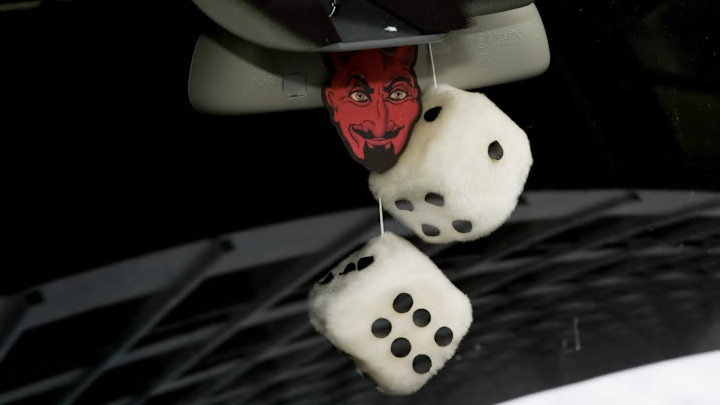In a column for the Petaluma Argus-Courier in February 1957, writer Bill Soberanes remarked on the newest trend among young drivers. “This columnist recently noted that the latest fad among the young set was the use of fuzzy dice to decorate their automobiles,” he wrote.
The casino-style dice, which could be purchased for as little as 59 cents at the time, were often found dangling from rearview mirrors. They seemed to hold no deeper meaning than being irreverent. But these dice actually meant a great deal to a generation that had just suffered through a world war.
Dice Roll
Settling on a documented origin for fuzzy dice is a fuzzy (and somewhat dicey) proposition. No one has ever stepped forward to claim credit, though automobile owners have been decorating their cars going back to the Ford Model T, which offered an optional speedometer accessory. In the 1920s, foxtails dangling from doors and windows was a hot trend. That gave way to fresh flowers in the 1930s.

It’s likely that the idea of hanging dice began with stories of pilots during World War II. The airmen associated dice with gambling, and gambling with luck. It made sense to try and summon that luck when flying on dangerous missions, and so dice ended up in cockpits.
When pilots returned home and settled into a postwar suburbia, they bought homes and cars—the latter decorated with the same good-luck dice they may have associated with coming home alive. Hanging dice became a charm, one that eventually migrated to the hot rod subculture of the 1950s. Those who reveled in the aesthetic of the car hung dice, painted flames on the sides of cars, and generally personalized their wheels however they could. In what is likely an urban legend, it’s possible the dice were symbolic of a driver ready to roll the dice, or risk death, in a street race.
While that might explain why a handful of military personnel embraced the dice and why a small group of thrill-seekers adopted the trend, it doesn't quite explain why it became such a phenomenon. One possible explanation: car magazines. According to the Detroit Free Press, hot rod periodicals of the ‘50s put the dice on display in photo layouts, likely causing readers to seek them out for themselves.
But why fuzzy? At the time the dice were being hung from mirrors, American culture seemed preoccupied with furry coverings. One car catalog of the 1960s offered prospective buyers an interior covered in “angora-type fur.” The material covered car seats, steering wheels, and doors.
Who exactly decided dice should be hairy, too, is an open question—though Long Island entrepreneur Mel Haber made a small fortune peddling them in the 1960s. For Haber and others, the dice were an easy blend of two of America’s car obsessions: lucky dice and furry things. Together, they made for a conversation piece. The dice didn’t quite say that the driver toyed with death, only that they were amused by mass-produced novelties.
Lucky Break
In the 1980s, the practice of personalizing a car was still going strong, with psychologists observing that cars were extensions of the home—a kind of mobile living room that people wanted to decorate owing to the amount of time spent on commutes and other trips. Garfield window toys, hula dancers, bobbleheads, and other ephemera were stuffed into cabins. Fuzzy dice were eventually tossed to make room for more modern kitsch, though they made a brief comeback in the 1990s to accompany a wave of nostalgia prompted by golden oldies stations.

While tacky decorating isn’t illegal, hanging something from your rearview can be. Most states have laws prohibiting anything obscuring the front windshield that might interfere with a driver’s field of vision—including air fresheners. Fuzzy dice were implicated in such laws as far back as the 1950s, when California declared rearview ornaments illegal. Critics of the law have argued the mandate often serves as a pretense to pull drivers over in the hopes of finding a more severe infraction.
As for newspaper columnist Soberanes: At the time he mentioned the fuzzy dice, he also noted that it seemed as though they might soon be replaced by another peculiar accessory. “[Someone] has just informed this corner that these fuzzy dice are giving way to new shrunken heads. I recently took a look at one of these heads, and although they are made of rubber, they look like the real McCoy. Wonder what the young set will think of next.”
